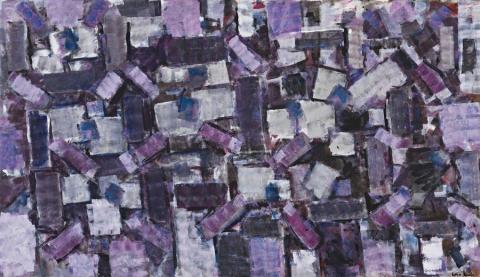SEQUENCE FIFTEEN, 1972
ROGER KEMP
synthetic polymer paint on paper on canvas
150.0 x 260.0 cm
signed lower right: Roger Kemp
Private collection
Deutscher~Menzies, Melbourne, 3 May 2000, lot 16
Company collection, Melbourne
Bonhams & Goodman, Melbourne, 7 August 2007, lot 153
Private collection, Melbourne
Deutscher~Menzies, Sydney, 18 March 2008, lot 42 unsold
Private collection, Melbourne
Roger Kemp: Cycles and Directions 1935-1975, Monash University, Melbourne, 1978, (illus., unpaginated)
Heathcote, C., A Quest for Enlightenment: The Art of Roger Kemp, Macmillan, Melbourne, 2007, p. 260
Sequence Fifteen, 1972 was painted several months after Roger Kemp returned from an extended residence in Britain. In stylistic terms this composition has the rhythmic looseness typical of Kemp's best post-London work, geometry being used in an elated and jaunty manner. Besides leaving behind that sombre rigidity of his 1960s paintings, where works were criss-crossed by a scaffold of heavy black lines, he also employs a new cool palette of purple, mauve and blue with pearl grey and brown sub-units.
Sequence Fifteen shows Roger Kemp using the innovative method of contemporary painting he introduced to Australia: acrylic was applied to a mural-scale sheet of artist's paper using a sponge roller. Kemp would unfurl and staple wide rolls of the imported paper across his studio wall, before quickly drawing a loose compositional structure in conte crayon. The artist paused to find some agreeable music on his radio 'a strong melody line was preferred' then he took up his painting tools and began improvising from the base design, letting the music carry him along. If it would take many hours, the painting was customarily completed in an intense single session which Kemp often likened to perfecting an inspired jazz composition.
The viewer can directly see how this long process of improvisational forming took place. The artist worked steadily as he put a rectangle in, followed by another, Sequence Fifteen being built in systematic steps according to an aesthetic equation in the artist's mind. Kemp had adopted sponge rollers as a means to avoid resorting to 'fill'. He never roughs out a shape then colours it in, the roller allowing him to directly apply acrylic as an irreducible rectangle.
The viewer will also see where the artist has edited himself by painting over a section in a different shade, or breaking a large rectangle into smaller blunt units. This causes the distinct layering effect, where loose rectangles sitting one over another, and which animates the composition with a joyous sense of restless activity. There is no mistaking the artist's elation as he worked.
Kemp was refining here what would be his signature implied symmetry of the mid 1970s: Sequence Fifteen may be wonky, and one side of the composition is not a mirror image of the other, but in a design sense the painting's right visually stabilises or completes the left. This was in keeping with the geometric abstract tradition he had studied intently in Europe and Britain; 'Their whole idea is balance,' the leading American painter Frank Stella had recently pointed out, 'You do something in one corner and you balance it with something in the other corner.'1 Likewise we notice how Kemp has not laboriously painted his way across Sequence Fifteen from one clear point, but constantly moved about with his roller, always maintaining an overall visual equilibrium. There was a serious intent to his using this improvised manner. Taken together these stylistic features mirrored Kemp's aim of employing art to take stock of the universe and the changing state of modern society.
1. Stella, F., quoted in Varnedoe, K., Pictures of Nothing: Abstract Art since Pollock, Princeton University Press, Princeton, 2006, pp. 100-1
DR CHRISTOPHER HEATHCOTE
